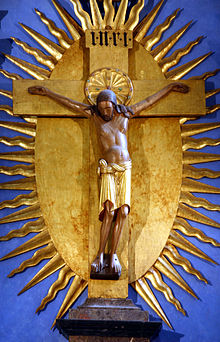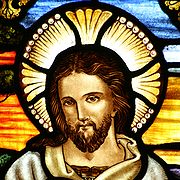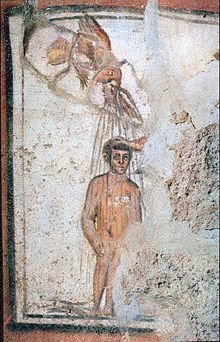- Christian symbolism
-
Christian symbolism invests objects or actions with an inner meaning expressing Christian ideas. Christianity has borrowed from the common stock of significant symbols known to most periods and to all regions of the world. Religious symbolism is effective when it appeals to both the intellect and the emotions. The choice of suitable acts and objects for symbolism is narrow enough that it would not be easy to avoid the appearance of an imitation of other traditions, even if there had been a deliberate attempt to invent an entirely new ritual.[1][2]
Contents
Early Christian symbols
Elemental symbols
Elemental symbols were widely used by the early Church. Water has specific symbolic significance for Christians. Outside of baptism, water may represent cleansing or purity. Fire, especially in the form of a candle flame, represents both the Holy Spirit and light. The sources of these symbols derive from the Bible; for example from the tongues of fire that symbolized the Holy Spirit at Pentecost, and from Jesus' description of his followers as the light of the world; or God is a consuming fire found in Hebrews 12.[3]
Ichthys
Among the symbols employed by the early Christians, that of the fish seems to have ranked first in importance. Indeed, from monumental sources such as tombs we know that the symbolic fish was familiar to Christians from the earliest times. It can be seen in such Roman monuments as the Capella Greca and the Sacrament Chapels of the catacomb of St Callistus. The fish was depicted as a Christian symbol in the first decades of the 2nd century.[4] The symbol itself may have been suggested by the miraculous multiplication of the loaves and fishes or the repast of the seven Disciples, after the Resurrection, on the shore of the Sea of Galilee.[5] Its popularity among Christians was due principally, it would seem, to the famous acrostic consisting of the initial letters of five Greek words forming the word for fish (Ichthys), which words briefly but clearly described the character of Christ and the claim to worship of believers: Iesous Christos Theou Yios Soter, meaning, Jesus Christ, Son of God, Saviour.[4]
Tomb paintings
Christians from the very beginning adorned their catacombs with paintings of Christ, of the saints, of scenes from the Bible and allegorical groups. The catacombs are the cradle of all Christian art.[6] Early Christians accepted the art of their time and used it, as well as a poor and persecuted community could, to express their religious ideas. From the second half of the 1st century to the time of Constantine the Great they buried their dead and celebrated their rites in these underground chambers. The Christian tombs were ornamented with indifferent or symbolic designs—palms, peacocks, with the chi-rho monogram, with bas-reliefs of Christ as the Good Shepherd, or seated between figures of saints, and sometimes with elaborate scenes from the New Testament.[6] Other Christian symbols include the dove (symbolic of the Holy Spirit), the sacrificial lamb (symbolic of Christ's sacrifice), the vine (symbolising the necessary connectedness of the Christian with Christ) and many others. These all derive from the writings found in the New Testament.[3] Other decorations that were common included garlands, ribands, stars landscapes, which had symbolic meanings, as well.[6]
Cross and crucifix
 The Crucifix, a cross with corpus, a symbol used by the Catholic Church, in Lutheranism, Eastern Orthodoxy, and Anglicanism, in contrast with some Protestant denominations, which use only a bare Cross.
The Crucifix, a cross with corpus, a symbol used by the Catholic Church, in Lutheranism, Eastern Orthodoxy, and Anglicanism, in contrast with some Protestant denominations, which use only a bare Cross.
The cross, which is today one of the most widely recognised symbols in the world, was used as a symbol from the earliest times. This is indicated in the anti-Christian arguments cited in the Octavius of Minucius Felix, chapters IX and XXIX, written at the end of that century or the beginning of the next,[7][8] and by the fact that by the early 3rd century the cross had become so closely associated with Christ that Clement of Alexandria, who died between 211 and 216, could without fear of ambiguity use the phrase τὸ κυριακὸν σημεῖον (the Lord's sign) to mean the cross, when he repeated the idea, current as early as the Epistle of Barnabas, that the number 318 (in Greek numerals, ΤΙΗ) in Genesis 14:14 was a foreshadowing (a "type") of the cross (T, an upright with crossbar, standing for 300) and of Jesus (ΙΗ, the first two letters of his name ΙΗΣΟΥΣ, standing for 18),[9] and his contemporary Tertullian could designate the body of Christian believers as crucis religiosi, i.e. "devotees of the Cross".[10] In his book De Corona, written in 204, Tertullian tells how it was already a tradition for Christians to trace repeatedly on their foreheads the sign of the cross.[11]
The Jewish Encyclopedia states:
- The cross as a Christian symbol or "seal" came into use at least as early as the second century (see "Apost. Const." iii. 17; Epistle of Barnabas, xi.-xii.; Justin, "Apologia," i. 55-60; "Dial. cum Tryph." 85-97); and the marking of a cross upon the forehead and the chest was regarded as a talisman against the powers of demons (Tertullian, "De Corona," iii.; Cyprian, "Testimonies," xi. 21-22; Lactantius, "Divinæ Institutiones," iv. 27, and elsewhere). Accordingly the Christian Fathers had to defend themselves, as early as the second century, against the charge of being worshipers of the cross, as may be learned from Tertullian, "Apologia," xii., xvii., and Minucius Felix, "Octavius," xxix. Christians used to swear by the power of the cross.[12][13]
Although the cross was known to the early Christians, the crucifix did not appear in use until the 5th century.[3] French Medievalist scholar and historian of ideas M.-M. Davy has described in great details Romanesque Symbolism as it developed in the Middle Ages in Western Europe.[14]
Lily crucifix
A lily crucifix is a rare symbol of Anglican churches in England. It depicts Christ crucified on a lily, or holding such a plant. The symbolism may be from the mediaeval belief that the Annunciation of Christ and his crucifixion occurred on the same day of the year, March 25.
There are few depictions of a lily crucifix in England. One of the most notable is a painting on a wall above the altar at All Saint's Church, Godshill, Isle of Wight. Other examples include:
- An alabaster example on a tomb in St Mary's Church, Nottingham.
- The Lady Chapel of St Helen's, Abingdon, Oxfordshire, has a wall painting.
- Five examples are in glass as at Long Melford Holy Trinity church.
- At All Saints, Great Glemham, Suffolk, the image is on the base of a font.
- At St Mary, Binham, Norfolk, an image in a bench end may be a lily crucifix.
- In Tong, Shropshire, St. Bartholomew's choir stall No. 8 depicts a lily crucifix.
- The Church of St John the Baptist, Wellington includes a Lily crucifix in the carving of the centre mullion of the east window of the Lady chapel.[15]
Peacock
Ancient people believed that the flesh of a peafowl did not decay after death, and it so became a symbol of immortality. This symbolism was adopted by early Christianity, and thus many early Christian paintings and mosaics show the peacock. The peacock is still used in the Easter season especially in the east.[16]
Symbols of Christian Churches
Sacraments
Some of the oldest symbols in the Christian church are the sacraments, the number of which vary between denominations. Always included are Eucharist and baptism. The others which may or may not be included are ordination, unction, confirmation, penance and marriage. They are together commonly described as an outward and visible sign of an inward and spiritual grace or, as in the Roman Catholic system, "outward signs and media of grace."[17] At the very least, the rite is seen as a symbol of the spiritual change or event that takes place. In the Eucharist, the bread and wine are, at the least, symbolic of the broken body and shed blood of Jesus, and in Roman Catholicism, become the actual Body of Christ and Blood of Christ through Transubstantiation, which in turn represent salvation brought to the recipient by the death of Jesus. The rite of baptism is, at the least, symbolic of the cleansing of the sinner by God, and, especially where baptism is by immersion, of the spiritual death and resurrection of the baptized person. Opinion differs as to the symbolic nature of the sacraments, with some Protestant denominations considering them entirely symbolic, and Roman Catholics, Orthodox, some Anglicans, and some Lutherans believing that the outward rites truly do, by the power of God, act as media of grace.[17]
Icons
The tomb paintings of the early Christians led to the development of icons. An icon is an image, picture, or representation; it is likeness that has symbolic meaning for an object by signifying or representing it, or by analogy, as in semiotics. The use of icons, however, was never without opposition. It was recorded that, "there is no century between the fourth and the eighth in which there is not some evidence of opposition to images even within the Church.[18] Nonetheless, popular favor for icons guaranteed their continued existence, while no systematic apologia for or against icons, or doctrinal authorization or condemnation of icons yet existed.
Though significant in the history of religious doctrine, the Byzantine controversy over images is not seen as of primary importance in Byzantine history. "Few historians still hold it to have been the greatest issue of the period..."[19]
The Iconoclastic Period began when images were banned by Emperor Leo III the Isaurian sometime between 726 and 730. Under his son Constantine V, a council forbidding image veneration was held at Hieria[20] near Constantinople in 754. Image veneration was later reinstated by the Empress Regent Irene, under whom another council was held reversing the decisions of the previous iconoclast council and taking its title as Seventh Ecumenical Council. The council anathemized all who hold to iconoclasm, i.e. those who held that veneration of images constitutes idolatry. Then the ban was enforced again by Leo V in 815. And finally icon veneration was decisively restored by Empress Regent Theodora.
Today icons are used particularly among Eastern Orthodox, Oriental Orthodox, Coptic and Eastern Catholic Churches.
Examples of other symbols
- Alpha and omega
- Anchor
- Apple
- Bestiaries
- Borromean rings
- Burning Bush
- Candles
- Christian flag
- Chi Rho and Labarum
- Cross and Crown
- IHS (monogram)
- Flaming sword
- Ichthys
- INRI
- Lamb
- Mitre
- Pentagram
- Pelican
- Rose Cross
- Shield of the Trinity (or Scutum Fidei)
- Star of David
- Trefoil
- Triquetra
- Vesica Piscis
See also
- Christian art
- Christian cross
- Holy Spirit in Christian art
- Peace symbols
- Saint symbology
- Symbols and symbolism in Christian demonology
- The Wordless Book
References
- ^ "Content Pages of the Encyclopedia of Religion and Social Science". http://hirr.hartsem.edu/ency/Symbols.htm. Retrieved 2008-10-31.
- ^ Thurston, Herbert (1912). "Symbolism". Catholic Encyclopedia. Robert Appleton Company. http://www.newadvent.org/cathen/14373b.htm. Retrieved 2007-11-26.
- ^ a b c Dilasser, Maurice. The Symbols of the Church (1999). Collegeville, MN: Liturgical Press, hardcover: ISBN 0-8146-2538-X
- ^ a b Hassett, Maurice (1912). "Symbolism of the Fish". Catholic Encyclopedia. Robert Appleton Company. http://www.newadvent.org/cathen/06083a.htm. Retrieved 2007-11-26.
- ^ John 21:9
- ^ a b c Fortescue, Adrian (1912). "Veneration of Images". Catholic Encyclopedia. Robert Appleton Company. http://www.newadvent.org/cathen/07664a.htm. Retrieved 2007-11-26.
- ^ ANF04. Fathers of the Third Century: Tertullian, Part Fourth; Minucius Felix; Commodian; Origen, Parts First and Second | Christian Classics Ethereal Library
- ^ Minucius Felix speaks of the cross of Jesus in its familiar form, likening it to objects with a crossbeam or to a man with arms outstretched in prayer (Octavius of Minucius Felix, chapter XXIX).
- ^ Stromata, book VI, chapter XI
- ^ Apology., chapter xvi. In this chapter and elsewhere in the same book, Tertullian clearly distinguishes between a cross and a stake.
- ^ "At every forward step and movement, at every going in and out, when we put on our clothes and shoes, when we bathe, when we sit at table, when we light the lamps, on couch, on seat, in all the ordinary actions of daily life, we trace upon the forehead the sign" (De Corona, chapter 3)
- ^ see Apocalypse of Mary, viii., in James, "Texts and Studies," iii. 118
- ^ JewishEncyclopedia.com - CROSS:
- ^ M.-M. Davy, Initiation à la Symbolique Romane. New edition. Paris: Flammarion, 1977.
- ^ "St John the Baptist, Wellington". Wellington and District Team Ministry. http://www.wellingtonteamchurches.org.uk/wellingtonChurch.html. Retrieved 1 September 2011.
- ^ "Birds, symbolic." Peter and Linda Murray, Oxford Dictionary of Christian Art (2004).
- ^ a b Kennedy, D.J (1912). "Sacraments". Catholic Encyclopedia. Robert Appleton Company. http://www.newadvent.org/cathen/13295a.htm#IV. Retrieved 2007-11-26.
- ^ Ernst Kitzinger, The Cult of Images in the Age before Iconoclasm, Dumbarton Oaks, 1954, quoted by Pelikan, Jaroslav; The Spirit of Eastern Christendom 600-1700, University of Chicago Press, 1974.
- ^ Patricia Karlin-Hayter, Oxford History of Byzantium, Oxford University Press, 2002.
- ^ See Council of Hieria.
External links
- Symbols in Christian Art and Architecture Comprehensive general listing.
- Christian Symbols Net Very comprehensive site, complete with search engine.
- Christian Symbols and Glossary (keyword searchable, includes symbols of saints)
- ReligionFacts.com: Christian Symbols Basic Christian symbols A to T, types of crosses, number symbolism and color symbolism.
- Meaning of Colors for Flags Biblical meanings of color used for Christian worship flags.
- Color Symbolism in The Bible An in depth study on symbolic color occurrence in The Bible.
- Christian Symbol Wood Carvings Forty symbols at Kansas Wesleyan University
- Old Christian Symbols from book by Rudolf Koch
- Christian Symbols, Origins and Meanings
- Tree of Jesse Directory by Malcolm Low.
- Chrismon Templates Symbol outlines that can be use to create Christian themed projects
Part of a series on Christianity Jesus Christ 
Foundations Bible Theology Apologetics · Baptism · Christology · God · Father · Son · Holy Spirit · History of theology · Mary · Salvation · TrinityHistory and
traditionChurch Fathers · Early Christianity · Constantine · Ecumenical councils · Creeds ·
Missions · East–West Schism · Crusades · Protestant Reformation · ProtestantismDenominations
(List) and
MovementsWestern: Adventist · Anabaptist · Anglican · Baptist · Calvinism · Evangelical · Holiness ·
Independent Catholic · Lutheran · Methodist · Old Catholic · Pentecostal · Quaker · Roman Catholic
Eastern: Eastern Orthodox · Eastern Catholic · Oriental Orthodox (Miaphysite) · Assyrian
Nontrinitarian: Christadelphian · Jehovah's Witness · Latter Day Saint · Oneness Pentecostal · UnitarianTopics Art · Criticism · Ecumenism · Liturgical year · Liturgy · Music · Other religions · Prayer · Sermons · SymbolismCategories:- Christian symbols
- Christian iconography
- Religious symbols
Wikimedia Foundation. 2010.





